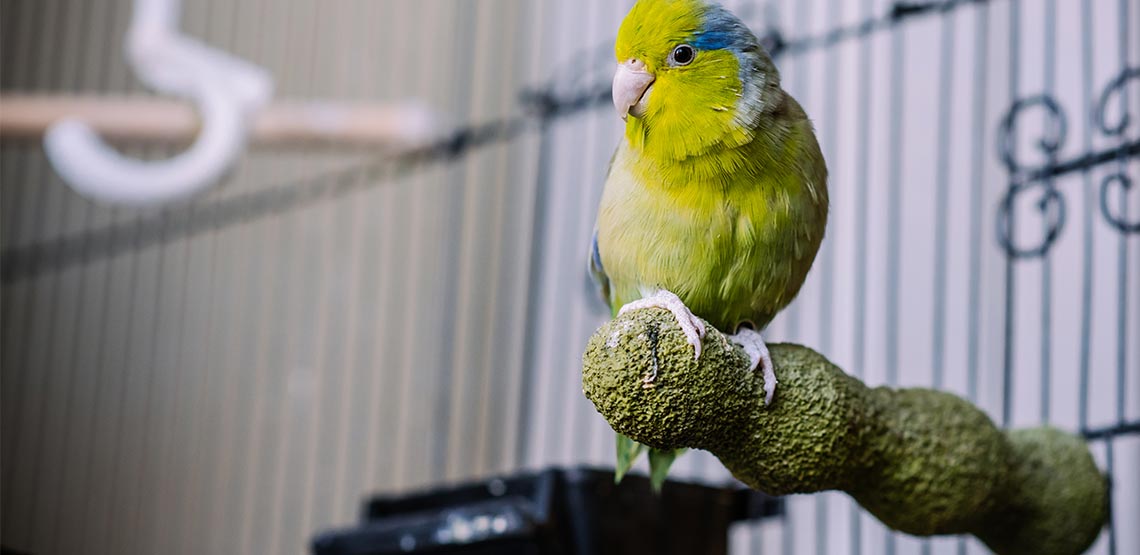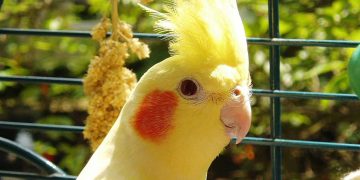Vital for Your Bird's Health
A bird perch is one of the most important parts of a bird cage. If you’re planning to buy a bird, you need to give it something to stand on, something to chew on, something to scratch its beak on, something to trim its nails on, and something to play with.
How can you fit all of this into one cage? Buy a perch. It’s vital for your pet bird’s health. However, the variety of perches can be overwhelming. How do you choose the best one? We’ve outlined some of the most popular types of bird perches, and how to pick the best option for your new pet.
Types of Bird Perches
Wooden Perches
Natural perches are usually made of wood. You can either buy one at a pet store or make it yourself (we’ll get to this later). Natural perches may not be as long-lasting as synthetic ones, but they are more appealing to birds. They are safe to chew and offer a piece of a bird’s natural environment.
When choosing a wooden perch, make sure it doesn’t have any spray coating. Otherwise, it’s not safe to chew on. Manzanita perches are the toughest. Ash, dogwood, magnolia, and cholla are all a good choice of wood for natural perches.
Dowel Perch
This common perch usually comes with the cage. It’s a good addition to your perch collection but should never be the only perch in a cage since it doesn’t provide equal pressure to all points of the bird’s feet, which can lead to health problems.
Edible Perches
Many pet stores offer edible perches that double as nutrition for your bird. The most popular are calcium perches. Caged birds often don’t get enough calcium, so buying such a treat can keep it healthy. These perches are not long-lasting but they are great for walking and chewing, so you can kill two birds with one stone. (No pun intended.)
Sandy Perches
Sandy perches are great for nail trimming. Caged birds often suffer from overgrown nails because they don’t have an opportunity to file them. The sandy coating of a wooden perch is not harmful to the bird. These perches serve several purposes, as they also provide a great place to stand.
Heated Perches
A heated perch is great for warmth-loving birds who suffer during cold winters. Instead of heating up the whole house, owners can use heated perches. Birds enjoy feeling the heat and usually spend most of their time roosting on them.
Cement Perches
Cement perches are great for beak and nail trimming. They are long-lasting and easy to clean. However, you will need to buy at least one more perch for your bird since walking solely on cement may hurt it’s feet.
Plastic Perches
Plastic perches are the most affordable option. They are usually durable and come in all shapes and sizes. However, they are not suitable for chewing since ingesting plastic is harmful for a bird. You need to be careful when choosing plastic perches, and buy only the highest-quality products.
Rope Perches
Some birds love swinging on rope perches. They offer a great exercise, and the ropes are fairly durable and easy to wash. However, you need to be extra careful when inspecting the rope, as damaged ropes can catch a bird’s foot.
You May Also Like:
Related Search Topics (Ads):
How to Choose the Ideal Bird Perch
Once you know which type of perch to buy, the rest is easy.
- Choose at least one rigid and one non-rigid perch for the cage.
- Perches should be as large as possible but still leave some space for flying. They shouldn’t block access to food and water.
- Don’t buy sandpaper perch covers. They tend to hurt the bird’s feet. It’s better to invest in a soft, sandy, or cement perch.
- Don’t go for cheap plastic perches. They are a hazard.
- Birds like porous wood, even though it’s not very long lasting. Consider it as a good non-rigid perch candidate.
Things to consider when choosing a bird perch:
- Material
- Size
- Durability
- Number
The ideal bird perch collection includes a soft perch made from natural material, an edible perch, and a cement or sandy perch for nail and beak trimming. If your cage is too small, you can skip the edible perch, but the other two are vital to your bird’s health.
Perch Tip #1
Buy several perches for your bird. One is never enough. Birds need to put equal pressure on all parts of its feet in order to stay healthy. One perch may not provide this option.
Perch Tip #2
Check the perches for damage on a regular basis. Damaged perches can harm a bird. Natural perches usually need to be replaced about once a month.
How to Make a Bird Perch
If you are on a tight budget, love DIY projects, or both, you may want to make a bird perch on your own. It’s fairly easy.
- Measure the cage to figure out the size of the perch you need.
- Find an untreated and unsprayed tree and cut a branch off.
- Sterilize the wood in a bleach solution (1 part bleach, 10 parts water) by soaking it for 10 minutes, then rinsing and air-drying.
- Take small wooden blocks and place them outside the cage at the perch level.
- Hold the wooden blocks outside and the branch inside the cage.
- Drill the screw through the outside block into the perch so it stays firmly in place.
Helpful Tip #1
Another way to sterilize the wood is to wet it and bake in the oven at 300°F.
Helpful Tip #2
Bring branches of different diameter, sterilize them, and allow your bird to walk over them in order to determine the ideal size.

